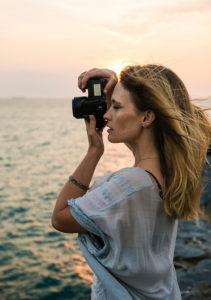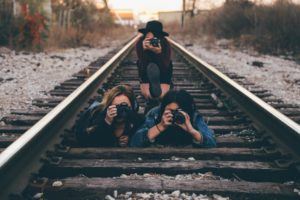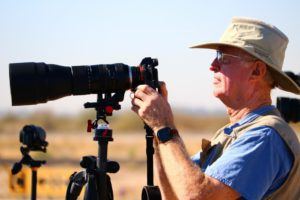
Commemorating important moments of people has been valuable to human-beings since the beginning of human existence. The invention of photography, and then the invention of personal cameras, digital cameras, and finally smartphones, has made it increasingly possible to commemorate earthshaking and trivial events alike. While snapping a photo is easier than ever, getting a shot that is up to the high standards of today’s media is more complicated than ever. There are many camera and lighting equipment options, and so many ways to edit a photo or video after the fact. Even if you are only an amateur photographer, taking one or more online photography lessons might be worth your while. With the continuing rise of social media, the demand for amateur and professional photography skills is increasing. A lot of people probably get quite good with the camera in their phone – simply because they use the feature so much; however, if you are someone who would like to take a more methodical approach, taking an online class is likely to be gratifying. Intermediate hobbyists and professionals who are passionate and ambitious also benefit from online resources that allow them to keep improving
Basics of Photography
Photography relies on the science of optics. All cameras have lenses. A lens is a clear material that is carefully shaped to direct light rays in a certain way. Light is energy that transmits by waves of a range of wavelengths. The wavelength determines the color of the light. Waves that are outside the range that the eye can detect may convey energy, but your eyes will not see it. Photography, of course, deals in visible light rays. Light can be very intense (energy is concentrated) or dim; light can be directed at different angles, so that it reflects off some objects more intensely than others. Ultimately, what you see (and what a camera detects) is light reflected from objects. Photographers learn to use the behavior of light to their advantage.

Modern photography relies heavily on software. Formerly, developing photographs was a manual process, involving fascinating chemistry and physics. However, nowadays, photos and videos are usually taken and stored digitally with a DSLR (digital single-lens reflex) camera. Then, the raw photos and videos are put through what professionals call editing or post-production, but most of us colloquially call it photoshopping. The reason this expression has taken hold is that Adobe Photoshop is the dominant suite of software in the field of photography. Photoshop has software to edit, organize, and save photos – for amateurs and professionals alike.
There is also the aesthetic side of photography. Photographers need to be sensitive to what makes an attractive photograph and how to make the photograph tell a story or express an idea. It turns out that the line between aesthetics and technicality is blurred in photography. However, for many, this may be a source of fascination: What is the perfect lighting, lens, position, etc. to say what you really want to say about your subject? While a good photographer usually has a workflow (a procedure to get a desired result), experimentation is always valuable, especially for the ambitious learner. Innovative photographic techniques can greatly change the look and feel of photos – and potentially, take hold and become trendy, or even iconic.
Of course, since the most commonly photographed and videoed beings are humans, the photographer must be sensitive to the physical, psychological, and even spiritual aspects of the human subject. The person paying for a professional headshot or family portrait probably wants a photo that is self-expressive and/or conveys a certain message. The photographer needs to either get to know the objects to be photographed or intuitively feel out what might be desired. Aside from issues of lens and lighting, the photographer needs to establish what sort of backdrop or props would be helpful (if these are not already given) and the photographer needs to know how to position the people and objects in relation to one another to get the right image into the camera. The editing stage also requires sensitivity to the desires of the client.

Subcategories of Photography
Food photography is on the rise. It is true that food-related publications always needed appetizing shots of foods featured by restaurants or photos to accompany recipes. However, social media has encouraged many amateur food photographers, and food blogging is practically a business in itself. In fact, if you are a food blogger, restaurant owner, or other food industry worker, it is worth looking at, and possibly purchasing, some of the top photography classes online.
Newborn and maternity photography could really be seen as two different categories, but for obvious reasons, they tend to come together. Newborns (and infants, in general) have unique needs when it comes to posing for a photography; furthermore, their safety has to be considered. Pregnancy photos could be seen as a unique category of portrait; however, the positioning of the client, along with clothing and props are usually different.
The portrait is probably the most common feat for the photographer: this can include family photos, individual portraits, and professional headshots. Aesthetic elements such as positioning and message are key. For example, an aspiring actor might want a very different sort of headshot from an accountant looking to have an inviting but professional online profile.
A less common, but highly innovative, category is fine art photography. Here the photographer is not so much a record-maker, but rather he/she is the artist. Fine art photographs are made to be beautiful, inventive, and thought-provoking – in the same way that paintings and sculptures are.
Also, filmmaking is a photography category, in and of itself. As one would expect, videos offer challenges and possibilities different from photographs. Sound and motion are involved, but the same general challenges of photography described above are still in play.
Creativelive as a Creative Hub for Photographers
Creativelive is an online educational site that offers courses and other resources in five broad categories: photo and video, art and design, music and audio, craft and maker, and money and life. The site’s live courses are taught by inspirational and experienced instructors who often have a body of award-winning work in their field. Buying a course gives life-long access to the course material, but classes can be viewed for free when they are on the air. Also, the site, including its blog, offers a profusion of advice for professionals and hobbyist in these fields. There is even an option to give a course to someone as a gift: If you know a reluctant want-to-be artist or innovator, this is the perfect thing.
The best Creativelive course (and arguably one of the top photography classes online) for a beginner is ‘Fundamentals of Photography,’ taught by John Greengo, an outdoor photographer with 30 years of experience. The course extensively covers the technicalities and skills of photography as a whole. Students are impressed: this course is recommended by 99% of students.
If you want a beginner/intermediate course that focuses more on the editing phase, then ‘Adobe Photoshop CC: The Complete Guide,’ taught by Ben Willmore, is a good one to consider; Willmore is one of America’s top Adobe Photoshop instructors, but his teaching and writing on the topic has reached people worldwide. This particular course is recommended by 99% of students.
Since light is a universally important element in photography, photographers of all experience levels might want to look at ‘Conquering Crappy Light,’ taught by Lindsay Adler and Erik Valind. This course is recommended by 100% students. Adler is a well-published fashion photographer and photography educator. Valind is a freelance photographer who specializes in lifestyle and environmental photography and brings his own uplifting style to the art. Creativelive instructors, as a group, are not just knowledgeable; they are also exciting people to experience.
Joining Creativelive makes you part of an encouraging online community of artists, businesspeople, and innovators. You can even be part of the live audience for a class, giving you the chance to meet in person like-minded people and leaders in your field of interest. Even better, all of the topics covered on Creativelive are potentially interconnected, making it easier to step out of your comfort zone and expand your horizons in a way that fits your goals.
Photography Is Valuable to You (No Matter Your Skill Level)
Smartphones have made photography ubiquitous – everyone is more of a photographer than they otherwise would have been. People take photos of their meals, whether restaurant or homemade.
Then there is the selfie: it is the first thing most people want to do if they meet a celebrity, go to a beautiful location, or make a friend. Online media is usually skimmed quickly, so photos or videos are essential to getting your post noticed. In our modern world, there are more and more lucrative and rewarding opportunities for professional and amateur photographers alike.